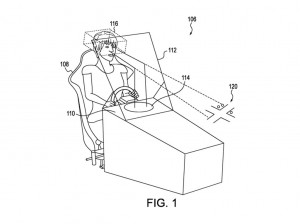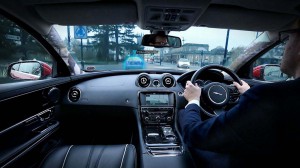You wouldn’t have to be Superman to have extra-human vision, at least not if Honda has its way.
The third-largest Japanese automaker has revealed a system it is developing that would allow a driver to see things – notably pedestrians – who might by hidden behind a truck or building but walking towards an intersection.
The concept uses a variety of sensors to look beyond a driver’s normal line of sight and then display a warning on the windshield using a Head-Up Display, or HUD. Considering pedestrians fatalities have been rising sharply in recent years, the technology could have a major impact on safety.
A new patent application filed by Honda illustrates the way the concept works. It is designed to watch out for pedestrians as the vehicle approaches an intersection. Sensors – including some of the same ones that might eventually be used to allow a vehicle to drive autonomously – can look beyond the normal line of sight.
(Honda patent app could signal plans for 11-speed transmission. Click Here for the story.)
In the past, Honda also demonstrated a way to watch for pedestrians and bicyclists by tracking signals from their cellphones or other two-way devices.
Whichever way the information is collected, it would then be used to signal a driver. As the vehicle approaches an intersection, a warning would be flashed, an avatars would pop up on a HUD display representing pedestrians who might be ready to walk in front of the vehicle.
Head-up systems were first used in military fighter jets as a way to present more information to a pilot without forcing them to look all over their instrument panel. The technology is becoming increasingly common in today’s cars. And where early HUD systems provided basic data, such as a vehicle’s speed, they now can offer more detailed information, such as turn-by-turn route guidance.
But the Honda system would adopt an almost three-dimensional layout to help the driver to figure out where a potential “target” might be. And the Honda patent application shows how the system could also provide a birdseye view making that process even easier. That would be similar to the around-view displays now found on a number of new models.
Whether Honda will actually take its system to market is unclear, but automakers are rapidly developing new safety technologies using camera, laser, radar and other sensors. And those technologies are expected to become widespread in the decade ahead as the first semi- and fully autonomous vehicles come to market.
(Ford takes us for a ride in its autonomous Fusion prototype. Click Here to tag along.)
In fact, such a pedestrian detection system – minus the head-up display – would almost certainly have to be integrated into a self-driving vehicle.
Honda isn’t the only one trying to give driver’s Superman-like vision. Jaguar recently showed of a high-tech concept that would take head-up displays a step further. It would augment reality by making it appear as if the pillars framing a car’s windshield were invisible.
Dubbed the “360 Virtual Urban Windscreen,” an LCD display would be embedded in each of the pillars, displaying an image from outside the car using cameras that cover the vehicle’s blind spots. It would effectively create transparent pillars giving the driver an unobstructed view of the world around.
(On range, Chevy’s new Bolt beats Tesla Model 3 by a mile – actually 23 miles. Click Here for the story.)



